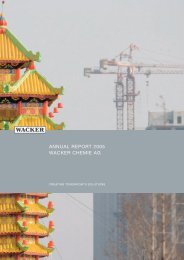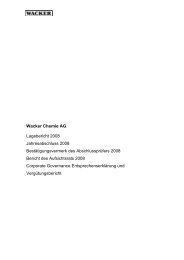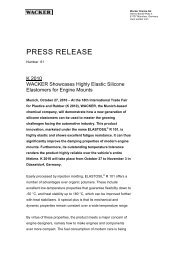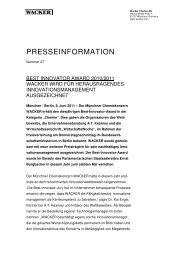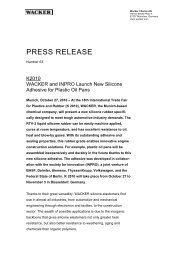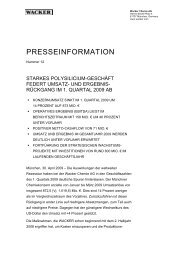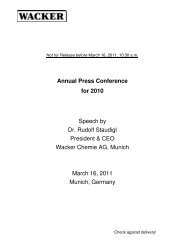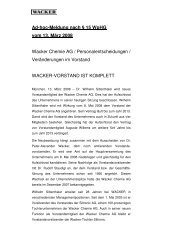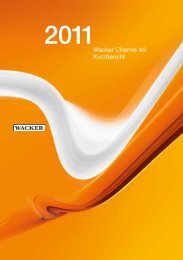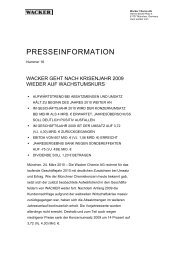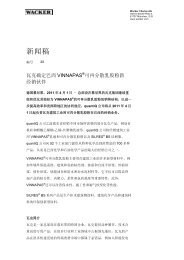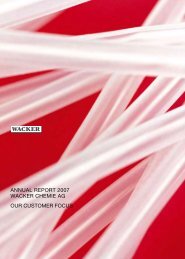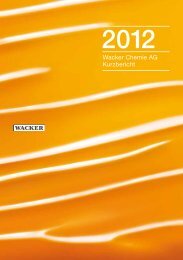EN (PDF | 1.3 MB) - Wacker Chemie
EN (PDF | 1.3 MB) - Wacker Chemie
EN (PDF | 1.3 MB) - Wacker Chemie
You also want an ePaper? Increase the reach of your titles
YUMPU automatically turns print PDFs into web optimized ePapers that Google loves.
LASTING PROTECTION FOR BUILDING FABRIC –<br />
WITH SILRES ® BS SILICONE MASONRY<br />
PROTECTION AG<strong>EN</strong>TS<br />
CREATING TOMORROW’S SOLUTIONS
WATER-REPELL<strong>EN</strong>T TREATM<strong>EN</strong>T:<br />
RELIABLE PROTECTION AGAINST<br />
MOISTURE
The term “water-repellent treatment”<br />
refers to the treatment of mineral<br />
substrates, especially facades of fairfaced<br />
masonry and concrete, with<br />
hydrophobic impregnating agents.<br />
The term “impregnating agent” is<br />
frequently used on its own in this<br />
context, since it is considered self-<br />
evident that these agents are hydrophobic,<br />
that is, water-repellent. By<br />
definition, however, “to impregnate”<br />
just means to saturate an absorbent<br />
material with a low-viscosity, capillary-<br />
active liquid.<br />
SILRES ® BS is a registered trademark of <strong>Wacker</strong> <strong>Chemie</strong> AG.<br />
Contents<br />
Water-Repellent Treatment: Reliable Protection against Moisture 2<br />
Moisture: Absorption by Masonry and Resulting Damage 4<br />
Water Repellents: A Sure Guarantee of a Comfortable Ambience 8<br />
Silicone Resins: Reliable Vehicles of Water Repellency 2<br />
Silanes and Siloxanes: Stable Compounds 4<br />
Customized Rather than Standardized Active-Agent Concentrations 8<br />
General-Purpose and Specialty Products: Solutions for Every Application 22<br />
WACKER Water Repellents for Maximum Effectiveness 26<br />
Stone Stengthening with Ethyl Silicates 2<br />
Long-Term Studies: Well-Known Reference Objects 6<br />
Your Silicone Masonry Protection Team 40<br />
WACKER at a Glance 4<br />
It follows that impregnations – also of<br />
masonry – do not necessarily imply water-<br />
repellent treatment. They may serve, for<br />
example, to strengthen and consolidate<br />
the masonry, or to imbue it with biocidal<br />
properties.<br />
In this brochure, however, impregnating<br />
agents are understood to be hydrophobic<br />
agents, that is, compounds which confer<br />
water repellency on mineral substrates.<br />
The purpose of water-repellent treatment<br />
is to protect exposed facades from moisture<br />
and attendant damage by applying<br />
a colorless, non-film-forming agent which<br />
prevents capillary uptake of water and<br />
the aggressive substances dissolved<br />
therein. Because the impregnating agent<br />
does not block the capillaries, the substrate<br />
retains its vapor permeability.
MOISTURE: ABSORPTION BY MASONRY<br />
AND RESULTING DAMAGE<br />
4
The mechanisms of water uptake by<br />
building materials are as varied as<br />
the possible forms of damage to the<br />
building. This chapter deals with the<br />
mechanisms of capillary water uptake,<br />
condensation, and hygroscopic water<br />
uptake, as well as the consequences<br />
for the building fabric.<br />
Stone fabric damaged by the effects of<br />
salt and moisture.<br />
When mineral building materials come<br />
into contact with water, they absorb an<br />
amount which depends on their porosity.<br />
The result is various forms of damage,<br />
including:<br />
- Penetration of moisture through the wall<br />
- Cracks caused by swelling and<br />
shrinkage<br />
- Damage caused by frost and<br />
de-icing salt<br />
- Destruction of concrete caused by<br />
corrosion of the reinforcing steel<br />
- Efflorescence and salt damage caused<br />
by hydration and crystallization<br />
- Lime leaching<br />
- Rust stains and curtaining<br />
- Dirt pick-up and curtaining<br />
- Attack by fungi, moss, lichens and<br />
algae<br />
- Chemical corrosion, e. g. binder<br />
transformation caused by acidic gases<br />
(SO 2 , NO 2 )<br />
- Impaired thermal insulation<br />
Algal growth on exposed construction<br />
elements with a high moisture content.<br />
Many of these forms of damage can be<br />
prevented, or at least reduced or kept at<br />
bay for longer, by means of impregnation.<br />
Creation of a water-repellent zone considerably<br />
reduces the uptake of water<br />
and aggressive substances; the masonry<br />
remains dryer, and is consequently less<br />
prone to the kinds of damage referred<br />
to above.<br />
However, this is only true of capillary<br />
water uptake, which is the “natural”<br />
water uptake by building materials when<br />
they come into contact with water –<br />
when a facade is exposed to rain, for<br />
example. There are various mechanisms<br />
of water absorption other than capillary<br />
water uptake, and these include<br />
condensation, capillary condensation,<br />
and hygroscopic water uptake.
Capillary Water Uptake<br />
Capillary water uptake is responsible for<br />
the penetration of large volumes of<br />
water into the building material within a<br />
short time. The amount of water absorbed<br />
depends primarily on the radius<br />
of the capillary pores in the building material.<br />
There are three pore categories:<br />
6<br />
Micropores have a radius of less than<br />
10 -7 m, gel pores less than 10 -8 m. These<br />
small pores do not permit capillary water<br />
transport. Water can only penetrate<br />
these pore spaces in the form of vapor.<br />
Consequently, building materials in<br />
which micropores dominate are practically<br />
impervious to water penetration by<br />
capillary action. They are likewise<br />
difficult to impregnate, since the water<br />
repellents cannot penetrate into these<br />
pores, either.<br />
Pores with a radius of between 10 -7 m<br />
and 10 -4 m are referred to as macropores<br />
or capillary pores. These pores support<br />
capillary action, and are able to transport<br />
water and other liquids in the building<br />
material to a degree dependent on their<br />
capillarity. Building materials with a high<br />
proportion of such pores are generally<br />
well suited for impregnation with water<br />
repellents.<br />
Air pores, as the third pore category,<br />
have a radius exceeding 10 -4 m. These<br />
large pores, like micropores, are unsuitable<br />
for capillary water transport.<br />
Capillary water absorption by mineral<br />
building materials is usually according to<br />
the “square-root-of-time law.” If water<br />
absorption W is plotted against the<br />
square root of the time t, a straight line<br />
is obtained, at least for the initial phase<br />
of capillary absorption. The gradient is<br />
referred to as the water-absorption<br />
coefficient, or often just as the w value:
Fig. 1<br />
y = water absorption [kg/m 2 ]<br />
16<br />
14<br />
12<br />
10<br />
8<br />
6<br />
4<br />
2<br />
0<br />
W = w ·√t<br />
Brick<br />
W water absorption [kg/m 2 ]<br />
w water absorption coefficient<br />
[kg/m 2 h 0. ]<br />
Ettring Tuff<br />
Monks Park limestone<br />
t absorption time [h]<br />
1 2 3 4 5<br />
Sand-lime brick<br />
Clinker brick<br />
Burgpreppach sandstone<br />
Mortar slabs<br />
x = t [h 0.5 ]<br />
Miltenberg sandstone<br />
Engineering concrete<br />
Strictly speaking, the water absorption coefficient<br />
w describes the rate of capillary<br />
absorption characteristic of a particular<br />
building material, but it is frequently used<br />
as a measure of the capillary absorbency<br />
of building materials in general. The water<br />
absorption coefficient is determined as<br />
per ISO 52617.<br />
Fig. 1 shows characteristic water-absorption<br />
curves for different building materials.<br />
The w values range from 0.15 kg/m 2 h 0.5<br />
for the very dense bridge concrete to<br />
11.5 kg/m 2 h 0.5 for the highly absorbent<br />
brick.<br />
Hygroscopic Water Absorption<br />
The presence of soluble salts increases<br />
the equilibrium moisture content of<br />
building materials due to the salts’ hygroscopicity,<br />
i.e. their ability to attract<br />
water vapor. The extent of this hygroscopic<br />
moisture absorption is determined<br />
primarily by the chemical nature<br />
of the salts, by their concentration in the<br />
masonry, and by the moisture content<br />
of the ambient air. Hygroscopic water<br />
absorption is especially serious when<br />
nitrates are present in the masonry.
WATER REPELL<strong>EN</strong>TS: A SURE<br />
GUARANTEE OF A COMFORTABLE<br />
A<strong>MB</strong>I<strong>EN</strong>CE<br />
Unlike the various film-forming<br />
coatings, building materials that have<br />
been treated with a water repellent<br />
retain their vapor permeability. This is<br />
because organosilicon water repellents<br />
do not seal the pores at the surface<br />
of the mineral masonry substrate, but<br />
form a very thin layer on the pore<br />
walls. Siliconized pores are no longer<br />
wetted by water, and capillary water<br />
uptake is prevented.<br />
8<br />
It may be concluded from the above<br />
comments about the various water-uptake<br />
mechanisms that provided the<br />
building material has pores which do<br />
permit capillary action, or the salt content<br />
– at least in the surface zone – is<br />
not excessively high, capillary moisture<br />
absorption without doubt poses the<br />
most serious problem. In this case,<br />
water-repellent treatment is certainly one<br />
of the best ways to protect the masonry<br />
from moisture damage.<br />
Water repellents need to fulfill the following<br />
requirements:<br />
- Drastic reduction in water uptake<br />
- Retention of high water-vapor permeability<br />
- Extensive penetration<br />
- Adequate resistance to alkalis<br />
- Resistance to UV light<br />
- Surfaces not rendered shiny or tacky,<br />
or caused to yellow<br />
- Environmental compatibility<br />
Unlike film-forming coatings, such as<br />
those based on acrylic, polyurethane or<br />
epoxy resins, organosilicon water repellents<br />
do not seal the pores at the surface<br />
of mineral masonry, but simply form a<br />
very thin layer on the pore walls (Fig. 2).<br />
Fig. 2<br />
a b c<br />
A mineral surface with (a) a hydrophobic<br />
impregnation, (b) filled pores, and (c) a<br />
sealant film.
Water can no longer penetrate in liquid<br />
form into capillaries that have been rendered<br />
water-repellent, since, as a polar<br />
liquid, it is unable to interact with a<br />
non-polar, hydrophobic surface. In other<br />
words, pores which have been siliconized<br />
and are therefore hydrophobic can<br />
no longer be wetted by water.<br />
The degree of wetting can be determined<br />
quantitatively as the contact angle θ.<br />
Untreated surfaces of mineral building<br />
materials are wetted immediately by<br />
water, i. e. the drops of water spread out<br />
and are rapidly absorbed by the building<br />
material (Fig. 3a). If the same building<br />
material is treated with an impregnating<br />
agent, the drops of water are repelled in<br />
the form of beads and do not penetrate<br />
into the substrate (Fig. 3b).<br />
Fig. 3a<br />
hydrophilic material<br />
0°<br />
Wetting of a hydrophilic porous surface.<br />
Abb. 3a<br />
Fig. 3b<br />
hydrophiles Material<br />
0°<br />
hydrophobic material<br />
180°<br />
Wetting of a hydrophobic porous surface.
Water Vapor Can Diffuse<br />
Since the pores in hydrophobically treated<br />
masonry remain open, the building<br />
material retains its vapor permeability, or<br />
“breathability.” Accordingly, the passage<br />
of water vapor is impaired only slightly, if<br />
at all. This is of great importance, since<br />
moisture contained in the building material<br />
can diffuse to the outside in the form<br />
of water vapor without causing any<br />
damage, e.g. blistering and subsequent<br />
spalling, which frequently occur with<br />
thick surface coatings.<br />
0<br />
Water under Pressure is a Problem<br />
Ground water can be a serious problem<br />
in cellars, as can driving rain for highly<br />
exposed facades. The larger the pores<br />
in the building material are, the greater<br />
the problem.<br />
Since the pores are open, a water-repellent<br />
treatment obviously cannot always<br />
protect a building material from ground<br />
water or driving rain.<br />
However, properly applied water repellents<br />
are perfectly sufficient to render<br />
many standard building materials, such<br />
as sand-lime brick, clinker brick and<br />
plasters, resistant even to driving rain<br />
with velocities of 100 km/h and more.<br />
“Properly applied” in this context means,<br />
for example, that the water repellent<br />
produces a hydrophobic zone which is<br />
not merely superficial but extends to a<br />
good depth.<br />
The water repellent must accordingly be<br />
formulated such as to allow maximum<br />
penetration into the building material.<br />
Only then can the effectiveness of the<br />
hydrophobic impregnation be guaranteed<br />
for years or even decades.
SILICONE RESINS: RELIABLE<br />
VEHICLES OF WATER REPELL<strong>EN</strong>CY<br />
Fig. 4<br />
R<br />
2<br />
R<br />
R<br />
OEt<br />
0 Si 0 Si 0 Si 0 Si<br />
0<br />
Si<br />
R<br />
OEt<br />
0<br />
Si<br />
0<br />
0<br />
Si<br />
R<br />
R<br />
EtO<br />
Si<br />
R R R<br />
Molecular structure of silicone resins.<br />
Fig.<br />
Consistency of solid silicone resins.<br />
0<br />
R<br />
0<br />
R<br />
0<br />
Si<br />
R<br />
OEt<br />
The close structural similarity between<br />
fully cured silicone resins and natural<br />
quartz is the reason for the high affinity<br />
of silicone resins for silicate building<br />
materials, and for the exceptional<br />
durability of surfaces treated with<br />
these resins. Silicone resins boast<br />
excellent water repellency, and are<br />
completely resistant to many chemical,<br />
physical and biological influences.<br />
Organosilicon compounds have been<br />
recognized for over 40 years as the ideal<br />
active agents for the hydrophobic impregnation<br />
of absorbent mineral building<br />
materials. However, it is not the ubiquitous<br />
silicone rubbers (joint sealants) and<br />
silicone fluids (release agents and lubricants)<br />
that are used in masonry protection,<br />
but the third important category of<br />
silicones – silicone resins.<br />
Silicone resins are three-dimensionally<br />
crosslinked polymers with a silicon and<br />
oxygen backbone. The silicon atoms<br />
carry organic groups R and functional<br />
groups OR’ (usually, R is a methyl group<br />
and R´an ethyl group) (Fig. 4). The resins<br />
range from liquid to solid depending on<br />
the degree of curing, the molecular<br />
weight and the kind of functional group<br />
(Fig. 5). They are soluble in organic<br />
solvents such as white spirit or alcohols.
When applied to the building material,<br />
these silicone resins react with water, the<br />
remaining alkoxy groups being split off, to<br />
form a three-dimensional, densely crosslinked<br />
polysiloxane which is firmly attached<br />
to the building material by way of covalent<br />
Si-O-Si bonds (Fig. 6).<br />
Crosslinked silicone resin bonded to a<br />
substrate.<br />
A comparison of the molecular structure<br />
of a fully cured silicone resin (Fig. 7a)<br />
with that of natural quartz (Fig. 7b)<br />
makes the close resemblance clear. The<br />
fully cured silicone resin can be regarded<br />
as a quartz structure that has been<br />
modified with organic groups. This close<br />
structural resemblance is the reason for<br />
the high affinity of silicone resins for<br />
silicate building materials, and for the<br />
exceptional durability of the water-repellent<br />
treatment.<br />
Molecular structure of fully cured silicone<br />
resin.<br />
The organic group R confers excellent<br />
water repellency on the silicone resins.<br />
Since they are also fully resistant to<br />
many chemical, physical and biological<br />
influences, the resins’ water-repellent<br />
property is generally maintained for decades,<br />
provided that the water-repellent<br />
treatment is carried out properly, i. e.<br />
provided that the right amount of the<br />
right product for the substrate is applied,<br />
and that the concentration of active<br />
agent is high enough.<br />
Molecular structure of quartz.
SILANES AND SILOxANES:<br />
STABLE COMPOUNDS<br />
The ultimate aim of all hydrophobic<br />
impregnations is to guarantee effective<br />
masonry protection for as long as<br />
possible. This goal was not always<br />
achieved with the organic-solventbased<br />
silicone resins frequently used<br />
in the past, or with water-based<br />
methyl siliconates. Today, silanes and<br />
siloxanes form the basis of modern<br />
water repellents. They can be incorporated<br />
easily in a large variety of<br />
products, and have outstanding<br />
properties.<br />
4<br />
When silicone masonry protection was in<br />
its infancy, there were two main sorts of<br />
water repellents, namely solutions of silicone<br />
resins in organic solvents, and methyl<br />
siliconates in water.
Fig. 8<br />
Fig. 9<br />
OH - /H 2O<br />
[ CH3-SiO3/2 ] CH x 3-Si(OH) 2O -<br />
®<br />
Methyl silicone resin<br />
R<br />
R’O-Si-OR’<br />
OR’<br />
(a)<br />
Methyl siliconate<br />
R<br />
R’O -Si-O- R’<br />
OR’<br />
(b)<br />
Alkyltrialkoxy silane Alkylalkoxy siloxane<br />
2-8<br />
Silicone Resin Solutions and Siliconates<br />
Solutions of silicone resins are only of<br />
minor importance today as water repellents.<br />
On account of their relatively high<br />
molecular weight, they do not penetrate<br />
deeply enough into dense building materials.<br />
Under alkaline conditions, standard<br />
silicone resins are broken open and<br />
methyl siliconates are formed. These are<br />
water-soluble and are leached out of the<br />
facade by rain (Fig. 8).<br />
The silicone resin, along with the water<br />
repellency it confers on the substrate,<br />
thus dwindles with time. Aqueous solutions<br />
of potassium methyl siliconate<br />
(CH 3 -Si(OH) 2 O - K + ) are frequently used for<br />
in-plant impregnation of building materials<br />
of fired clay and fibrous gypsum. Alkali<br />
carbonates are formed as by-products.<br />
However, siliconates are no longer used<br />
for impregnating facades because they<br />
are apt to form a white deposit.<br />
The poor degree of penetration and<br />
insufficient resistance of silicone resin<br />
solutions to alkalis prompted the search<br />
for alternative active agents back in the<br />
mid 1970s.<br />
Silanes and Siloxanes<br />
Better penetration is achieved by using<br />
low-molecular rather than high-molecular<br />
compounds. This discovery marked the<br />
birth of water-repellent agents based on<br />
silanes and siloxanes. As is evident from<br />
the chemical formulae (Fig. 9), the silanes,<br />
on closer examination, are monomeric alkyltrialkoxy<br />
silanes, and the siloxanes are<br />
oligomeric alkylalkoxy siloxanes derived<br />
therefrom.
Resistance to Alkalis – a Criterion of<br />
Durability<br />
The second most important discovery<br />
on the way to developing today’s highly<br />
effective water repellents was how to<br />
influence the resistance of the active<br />
agent to alkalis through use of the appropriate<br />
organic group R. If R is always<br />
a methyl group, the reaction of Fig. 8,<br />
in the presence of alkali, will eventually<br />
lead to a complete loss of hydrophobicity.<br />
But if longer-chain organic groups are<br />
used in place of methyl groups, the<br />
reaction of Fig. 8 can still proceed, even<br />
though this is not easy for steric reasons.<br />
However, the resulting siliconate becomes<br />
increasingly water-insoluble as the length<br />
of the R group lengthens, thus preventing<br />
the siliconate from being leached out by<br />
rain. In consequence, the degradation<br />
reaction is suppressed, and the active<br />
agent remains in the form of a silicone<br />
resin network on the masonry.<br />
6<br />
The iso-octyl group has proved to be<br />
particularly suitable. Silanes and siloxanes<br />
with iso-octyl groups are readily available,<br />
can be incorporated in a large number<br />
of products and exhibit outstanding<br />
properties. Water repellents frequently<br />
contain a mixture of silicone components<br />
with short-chain methyl and long-chain<br />
iso-octyl groups.<br />
Silane and Siloxane Blends<br />
In this way, it is possible to formulate<br />
water repellents that are customized in<br />
terms of properties such as penetration<br />
power, resistance to alkalis, water-beading,<br />
etc. A water repellent for concrete<br />
will require, for example, more silane and<br />
more long-chain organic groups than a<br />
product used to impregnate sandstone<br />
or brick. Whereas concrete is usually<br />
very dense and highly alkaline, sandstone<br />
and brick are absorbent and more or<br />
less neutral.
Specialty Products for Maximum<br />
Effectiveness<br />
There is a whole range of building materials<br />
with properties between those of<br />
concrete and sandstone or brick. These<br />
materials include limestones and sandlime<br />
brick, clinker brick, mineral-based<br />
plasters and paints, aerated concrete,<br />
fiber-reinforced concrete, and many<br />
others. It is thus important to have balanced,<br />
general-purpose products, i. e.<br />
impregnating agents that are acceptably<br />
effective on all standard substrates.<br />
Where maximum effectiveness for a<br />
particular substrate is desired, silanes<br />
and siloxanes may be suitably blended<br />
to formulate a specialty product.
CUSTOMIzED RATHER THAN<br />
STANDARDIzED ACTIVE-AG<strong>EN</strong>T<br />
CONC<strong>EN</strong>TRATIONS<br />
A standard solution will not be able to<br />
confer maximum water repellency on<br />
every type of building material, as<br />
each material has different properties.<br />
Whatever the substrate, whether<br />
high-grade concrete or absorbent<br />
brickwork, the right impregnating<br />
agent in the right concentration is<br />
always needed. Impregating agents<br />
may be used in concentrations ranging<br />
from highly diluted to undiluted.<br />
Among the diluted products, aqueous<br />
water repellents are becoming increasingly<br />
important.<br />
The depth to which the active ingredient<br />
of an impregnating agent penetrates is<br />
directly dependent on the concentration<br />
of the active ingredient. The more a<br />
product is diluted, the less able it is to<br />
penetrate into the building material and<br />
fully occupy the walls of the pores and<br />
capillaries so as to prevent them from<br />
absorbing water. The capillary absorbency<br />
of building materials, for their part,<br />
varies enormously. If, for example, a vertical<br />
bridge-concrete surface is saturated<br />
8<br />
with water repellent by flooding, the highgrade<br />
concrete will absorb 80-100 g/m²<br />
at the most. An absorbent brick or<br />
sandstone facade, by contrast, will easily<br />
take up ten times this amount under the<br />
same conditions. To ensure that the active<br />
agent penetrates to an acceptable<br />
depth into the low-absorbency concrete,<br />
it is thus necessary to use a much more<br />
concentrated product than for the more<br />
absorbent sandstone or brick. In practice,<br />
use is made of undiluted silanes or silane/<br />
siloxane mixtures to render concrete<br />
water-repellent, while for natural-stone<br />
facades it is common to use products<br />
containing only 5-10 % active agent.<br />
Silanes and Siloxanes in Solution<br />
In keeping with their hydrophobic nature,<br />
silanes and siloxanes are soluble to<br />
an almost unlimited extent in organic<br />
solvents. Since, however, contrary to<br />
widespread opinion, silicone active<br />
agents penetrate into the pores of building<br />
materials better when dissolved in<br />
petroleum ether than in alcohols such<br />
as ethanol and 2-propanol, the latter are<br />
only used if there is any risk of the water<br />
repellent’s coming into contact during<br />
application with plastics or paints that<br />
are attacked by petroleum ether.<br />
Otherwise, low-odor, dearomatized<br />
white spirit or synthetic iso-paraffins are<br />
the most commonly used solvents.<br />
Care must be taken that whenever<br />
solvents are used, these are, if possible,<br />
anhydrous. The current trend is definitely<br />
toward solvent-free, that is, water-based<br />
products.
SILRES ® BS SMK – A Triumph over<br />
Difficulties<br />
The first breakthrough was the development<br />
of silicone microemulsion<br />
concentrates (sold under the name<br />
SILRES ® BS SMK).<br />
Silicone microemulsion concentrates are<br />
solvent-free mixtures of silanes, siloxanes<br />
and silicone surfactants, which, on dilution<br />
with water, yield ready-to-use silicone<br />
microemulsions.<br />
The advantage offered by these products<br />
results from the nature of the surfactants<br />
(emulsifiers and co-emulsifiers), which<br />
only function temporarily as such; once<br />
the water repellent has been applied to<br />
the building material, they transform into<br />
hydrophobic active-agent components.<br />
If the particle sizes of emulsions and<br />
microemulsions (Figs. 10a and b) are<br />
compared, it is clear that microemulsions,<br />
on account of the vastly greater particlesurface<br />
area, will require considerably<br />
more emulsifier than emulsions. The use<br />
of conventional surfactants would impair<br />
the hydrophobicity.<br />
The great advantage of SILRES ® BS SMK<br />
products, apart from their being waterdilutable<br />
and easy to handle, is the fact<br />
that they come in concentrated form.<br />
This makes for smaller container sizes,<br />
greatly reduces transport, storage and<br />
waste-disposal costs and lessens environmental<br />
impact.<br />
A disadvantage of SMK technology,<br />
however, is that the microemulsions have<br />
to be used within 24 hours of diluting<br />
them. Their appearance does not change<br />
in days or even weeks, but the alkoxysilanes<br />
and alkoxysiloxanes in the microparticles<br />
hydrolyze and polymerize to<br />
an increasing extent, making it harder<br />
and harder for the active agents to<br />
penetrate into the building materials.<br />
Fig. 10<br />
Water<br />
Oil<br />
a) Emulsion<br />
(Section of droplet)<br />
: Emulsifier : Co-emulsifier<br />
Water<br />
Oil<br />
b) Microemulsion<br />
Comparison of emulsion (a) and silicone<br />
microemulsion (b) particle size.
Impregnating Agents in the Form of<br />
Emulsions<br />
Aside from the product classes already<br />
mentioned, there are silane/siloxane<br />
emulsions which boast both dilution and<br />
storage stability. These emulsions are<br />
diluted with water in a ratio of 1:4 to<br />
1:9, the exact ratio depending on the<br />
type of substrate and the extent of water<br />
repellency required.<br />
The problem of using emulsions for impregnations,<br />
however, as was explained<br />
before, is that, if the products are to<br />
have properties comparable to those of<br />
conventional solvent-thinned impregnating<br />
agents, only low-molecular alkylalkoxy<br />
silanes and siloxanes are suited as<br />
active agents. But these silanes and<br />
siloxanes react with moisture, and therefore<br />
special tricks are needed to stabilize<br />
them.<br />
20<br />
The key to success lies primarily in the<br />
correct choice of emulsifiers, in adjusting<br />
the pH to the optimum value, and in the<br />
chemical nature and thus the reactivity<br />
of the active agents. It is advisable, for<br />
example, to employ ethoxy silanes and<br />
siloxanes rather than their methoxy<br />
counterparts, as the former hydrolyze far<br />
less quickly. The reactivity is, moreover,<br />
largely dependent on the nature of the<br />
organic group attached to the silicone:<br />
long-chain groups, such as the iso-octyl<br />
group, drastically reduce the tendency of<br />
silanes and siloxanes to hydrolyze.<br />
Impregnating Cream<br />
Unlike all other water repellents, impregnating<br />
agents in the form of cream may<br />
be applied without wastage even during<br />
overhead work.<br />
SILRES ® BS creams are best applied<br />
using airless equipment, with which up<br />
to 400 g/m² may be applied in a single<br />
operation.<br />
The impregnating cream penetrates<br />
completely into the substrate within a<br />
period of some minutes to some hours;<br />
the exact time required will depend on<br />
the amount applied. Very high depths of<br />
penetration are achieved due to the long<br />
time the cream is in contact with the<br />
construction material.
G<strong>EN</strong>ERAL-PURPOSE AND SPECIALTY<br />
PRODUCTS: SOLUTIONS FOR EVERY<br />
APPLICATION<br />
<strong>Wacker</strong> <strong>Chemie</strong> AG offers both longestablished<br />
water repellents and new,<br />
innovative masonry protection agents.<br />
Our product spectrum includes both<br />
general-purpose water repellents and<br />
specialty products for concrete.<br />
22<br />
<strong>Wacker</strong> <strong>Chemie</strong> AG has been intensively<br />
researching and developing silicone<br />
masonry protection agents for some fifty<br />
years. A large number of products have<br />
been developed during this time, many<br />
of which are still in use.<br />
However, the constant development of<br />
new water repellents necessitated<br />
streamlining the product portfolio and<br />
adapting it to today’s requirements.<br />
The outcome of these measures is a<br />
clearly organized product spectrum<br />
comprising the two categories: “generalpurpose<br />
water repellents” and “specialty<br />
products for concrete.”<br />
General-purpose products are defined<br />
as those impregnating agents which, in<br />
principle, confer good water repellency<br />
on a large variety of very different mineral<br />
substrates, ranging from highly alkaline,<br />
dense concrete to neutral, absorbent<br />
brick and natural stone.<br />
Specialty products for concrete, by<br />
contrast, are those products that confer<br />
long-term protection on high-grade<br />
reinforced concrete of the type used in<br />
bridge building. These products must be<br />
able to penetrate extensively into the<br />
building material, even into very dense<br />
concrete, and they must show excellent<br />
resistance to attack by alkalis.<br />
Table 1 (p. 25) contains a survey of the<br />
various products, their properties, and<br />
their fields of application.
General-Purpose Water Repellents<br />
The best-known and most frequently<br />
used water repellent is SILRES ® BS<br />
290. When used in the recommended<br />
concentrations of 1:11 to 1:15 (parts by<br />
weight), it produces excellent results on<br />
almost all absorbent mineral substrates.<br />
Particularly worth mentioning are its<br />
resistance to alkalis, its good penetration<br />
power and its outstanding beading effect.<br />
For many types of natural stone, in particular,<br />
there is to date still no alternative<br />
to SILRES ® BS 290. The hydrophobic<br />
silicone resin network forms within a few<br />
hours, even on non-alkaline substrates.<br />
SILRES ® BS SMK 1311 is a well-established,<br />
aqueous alternative to solventthinned<br />
products, and is suitable for a<br />
wide variety of building materials, e. g.<br />
sand-lime brick, bricks and mineral<br />
plaster. It should be diluted in a ratio of<br />
1:10 to 1:14 to suit the substrate in<br />
question. By virtue of its autocatalytic<br />
behavior, SILRES ® BS SMK 1311 reacts<br />
to form the hydrophobic silicone resin<br />
just as quickly as SILRES ® BS 290.<br />
However, on many types of natural<br />
stone, including sandstone, limestone<br />
and stone containing clay mineral, the<br />
effectiveness of the aqueous product<br />
may differ markedly from that of<br />
SILRES ® BS 290. Before treating a large<br />
area of masonry, therefore, it is a good<br />
idea to check the effectiveness of the<br />
water repellent on a test area. Like all<br />
silicone microemulsion concentrates,<br />
SILRES® BS 1311 should only be<br />
diluted with tap water on the day it is<br />
to be processed.<br />
Another of the general-purpose water<br />
repellents, SILRES ® BS 1001, is a 50-%<br />
silane/siloxane emulsion that is diluted<br />
with water to suit the consistency of the<br />
substrate in question. Before the emulsion<br />
is diluted and applied, it is advisable<br />
to stir it briefly so as to ensure that it is<br />
homogeneous. SILRES ® BS 1001 rapidly<br />
confers discernible water repellency on<br />
the building material, although the active<br />
agent takes a few days to some weeks<br />
to form completely. The exact length of<br />
time will depend on the alkalinity of the<br />
substrate.<br />
Since the emulsion breaks once it has<br />
been applied, and there is a pronounced<br />
beading effect as soon as the water has<br />
evaporated, the amount of active agent<br />
leached out by rain during the relatively<br />
long curing period is negligible. Like all<br />
aqueous products based on alkylalkoxy<br />
silanes and siloxanes, SILRES ® BS 1001<br />
is markedly less effective on some types<br />
of natural stone, especially limestone,<br />
than, for instance, solvent-thinned<br />
SILRES ® BS 290. It is therefore always<br />
essential to check its effectiveness on a<br />
test surface.<br />
2
Specialty Products for Concrete<br />
SILRES ® BS 1701 is a 100-% silanebased<br />
impregnating agent that is used to<br />
confer water repellency on concrete and<br />
reinforced concrete. It is usually<br />
applied to the concrete by flooding (wet<br />
on wet) at least twice in undiluted form.<br />
Of course, this water repellent may be<br />
diluted with organic solvents or alcohols<br />
in any mixing ratio desired. It should be<br />
remembered, however, that the more a<br />
given quantity of water repellent is diluted,<br />
the less deep the active agent will penetrate.<br />
Because of its iso-octyl silane groups,<br />
SILRES ® BS 1701 is much less volatile<br />
than other commercial silanes. However,<br />
under certain conditions, evaporation may<br />
cause some loss of active agent. This happens<br />
most frequently when the concrete<br />
is old, of low alkalinity, and is hot and dry<br />
at the surface due to exposure to the sun.<br />
In such cases it is advisable to resort to<br />
an aqueous product, in particular to the<br />
impregnating cream described below.<br />
SILRES ® SMK 2101 is similar in composition<br />
to SILRES ® SMK 1311, but contains<br />
24<br />
substantially more iso-octyl silane. This<br />
enhances its penetration power and resistance<br />
to alkalis. When SILRES ® SMK<br />
2101 is used to treat reinforced concrete,<br />
it should be diluted with water in a ratio<br />
of 1:4. Like all silicone microemulsions,<br />
the diluted product ought to be used on<br />
the same day it is mixed. SILRES ® SMK<br />
2101 is also especially suitable as a<br />
primer for concrete coatings.<br />
Unlike all the other products listed in<br />
Table 1, SILRES ® BS Creme C is not a<br />
liquid. Its thixotropic consistency makes<br />
it possible to apply the product without<br />
wastage even when working overhead.<br />
SILRES ® BS Creme C is best applied<br />
using airless equipment, with which up<br />
to 400 g/m² may be applied in a single<br />
operation. Such quantities often cannot<br />
be applied even in three operations<br />
when conventional low-viscosity products<br />
are used on high-grade concrete.<br />
The impregnating agent penetrates completely<br />
into the concrete within a period<br />
of some minutes to some hours, the<br />
exact time depending on the quality of<br />
the concrete and the amount of impregnating<br />
agent applied. No visible traces of<br />
the cream are left on the surface, and<br />
very great depths of penetration can be<br />
achieved.<br />
Thanks to the very pronounced penetration<br />
depth of several mm, even concrete<br />
with a damaged surface (cracks, spalling)<br />
is adequately protected. Tests have<br />
confirmed that a hydrophobic impregnation<br />
not only protects the concrete from<br />
moisture, but also minimizes pollutant<br />
ingress into the concrete. In test samples<br />
of treated masonry, chloride uptake<br />
is superficial only.<br />
In untreated building material, by contrast,<br />
considerable concentrations of<br />
chloride are detectable even at a depth<br />
of 4 mm (Fig. 11).
Fig. 11 Chloride migration in concrete (strength<br />
0.50<br />
class C / 4 )<br />
Untreated specimens and those treated with<br />
0.45<br />
SILRES<br />
0.40<br />
0.35<br />
® BS Creme C<br />
Specimens conditioned for 0 days in 0 %<br />
NaCl solution<br />
Chloride content (%)<br />
0.30<br />
0.25<br />
0.20<br />
0.15<br />
0.10<br />
0.05<br />
0.00<br />
Depth<br />
Untreated 100g/m 2 200g/m 2 300g/m 2<br />
Amount applied of SILRES ® BS Creme C<br />
0-9 mm 1.1-1.9 mm 2.1-2.9 mm 3.1-3.9 mm<br />
Table<br />
Products and<br />
applications<br />
All-Round Products Special Products for Concrete<br />
Product Properties<br />
SILRES ® BS SILRES ® BS SILRES ® BS SILRES ® BS SILRES ® BS SILRES ® BS<br />
2 0 SMK 00 0 SMK 2 0 Creme C<br />
Appearance Milky, colorless Clear, yellowish Clear, yellowish Clear, yellowish Clear, yellowish Clear, yellowish<br />
Silicone agent Silane/siloxane Silane/siloxane Silane/siloxane Silane Silane/siloxane Silane<br />
Product type 100 % 100 % 50 % 100 % 100 % 80 %<br />
concentrate microemulsion emulsion concentrate microemulsion cream<br />
solution concentrate solution concentrate<br />
Density [g/cm ] 1.05 0.95 0.95 0.90 0.90 0.90<br />
Viscosity [mm2 /s] 20 7 12 2 4 Non-sag<br />
Flash point [°C] 38 25 >100 70 25 74<br />
Diluent Solvent Water Water Undiluted/<br />
solvent<br />
Water Undiluted<br />
Shelf life (months)<br />
Applications<br />
12 12 9 12 12 12<br />
Sandstone<br />
Sand-lime brick<br />
Porous limestone<br />
Marble<br />
Granite<br />
Brick<br />
Mineral plaster<br />
Concrete<br />
Reinforced concrete<br />
Suitable Highly suitable Very highly suitable<br />
2
WACKER WATER REPELL<strong>EN</strong>TS<br />
FOR MAxIMUM EFFECTIV<strong>EN</strong>ESS<br />
The most important criteria which<br />
water repellents must satisfy are<br />
reduction in water uptake, penetration<br />
by the hydrophobic active agent,<br />
permeability to gas and water vapor<br />
and a beading effect. In the following<br />
section, these requirements will be<br />
described in more detail, and the<br />
effectiveness of the WACKER products<br />
compared on the basis thereof.<br />
26<br />
Capillary Water Uptake<br />
The most important requirement which a<br />
water repellent must fulfill is a significant<br />
reduction in capillary water uptake. A<br />
common specification is that the amount<br />
of water absorbed by a building material<br />
during 24 hours’ immersion in water be<br />
reduced by at least 80 %.<br />
Depth of Penetration<br />
In order that the reduced tendency to<br />
absorb water may be long-lasting, it is<br />
obviously not sufficient if the water-repellent<br />
effect is limited to the surface of the<br />
building material. It is essential that the<br />
hydrophobic zone extend deep below<br />
the surface, but it is difficult to give a<br />
general answer to the frequently-asked<br />
question as to exactly how deep. Of<br />
course, from a technical point of view,<br />
there is nothing against striving for<br />
maximum possible penetration, but it<br />
must be remembered that this is only<br />
achieved by applying a large quantity of<br />
active agent, which incurs high costs.<br />
For many substrates, a penetration<br />
depth in the order of a few millimeters is<br />
technically adequate and economically<br />
acceptable.
Beading Effect<br />
The third important criterion which water<br />
repellents must satisfy is the production<br />
of a beading effect. This effect is measured<br />
objectively by means of the contact<br />
angle Θ. The following classification is<br />
often used:<br />
Table 2<br />
Rating Very good repellency Contact angle Θ >130°<br />
Rating 2 Good repellency Contact angle Θ 110-130°<br />
Rating Slight wetting Contact angle Θ 90-110°<br />
Rating 4 Pronounced wetting Contact angle Θ 30-90°<br />
Rating Surface completely wetted Contact angle Θ
The Effectiveness of WACKER<br />
Products<br />
Tables 4a and 4b (page 30) show test<br />
results for water uptake, beading and<br />
penetration depth of various products<br />
applied to different substrates. White<br />
spirit with a low aromatics content was<br />
used as diluent for the solvent-thinnable<br />
products, and normal tap water for the<br />
aqueous products. All substrates were<br />
impregnated by means of immersion<br />
(immersion times: 1 minute for mortar<br />
and concrete, 5 minutes for all other<br />
substrates).<br />
The quantities of impregnating agent absorbed<br />
correspond approximately to the<br />
amounts absorbed when the products<br />
are applied to vertical surfaces by flooding<br />
in two wet-on-wet operations.<br />
Water absorption was determined 14<br />
days after impregnation, again by way of<br />
immersion (specimens were covered<br />
with 5 cm of water, in accordance with<br />
<strong>EN</strong> 12859). This method was chosen<br />
because the hydrostatic pressure exerted<br />
by the covering of water simulates,<br />
to a certain extent, the effect of driving<br />
28<br />
rain, making the procedure more realistic<br />
than the sponge immersion test described<br />
in ISO 15148, in which only capillary<br />
absorption is measured.<br />
To determine the penetration depth, a<br />
specimen of each product was broken<br />
14 days after impregnation and dyed<br />
water was dripped onto the fracture<br />
surface. The hydrophobic zone is not<br />
wetted by the dyed water.<br />
Gas Permeability<br />
The term “gas permeability”, when used<br />
in the context of water repellents, refers<br />
primarily to the impregnated structure’s<br />
permeability to water vapor and carbon<br />
dioxide.<br />
Water-vapor permeability is essential for<br />
allowing any moisture beneath the surface<br />
to dry. It is determined as follows,<br />
in accordance with ISO 7783-2: a sample<br />
of the substrate is cemented above<br />
a saturated salt solution contained in<br />
a cup. The salt solution provides for a<br />
constant and very specific relative<br />
humidity within the cup. In line with the<br />
recommendation given in the standard,<br />
frequent use is made of ammonium<br />
dihydrogen phosphate, with which a<br />
relative humidity of precisely 93 % is obtained.<br />
The cup is kept under standard<br />
conditions at 23 °C and 50-% humidity.<br />
By weighing it repeatedly over a period<br />
of several days, it is possible to determine<br />
how much water vapor diffuses<br />
through the substrate. Since the surface<br />
area of the substrate is known, the<br />
water-vapor permeability, WVP, can be<br />
calculated in [g/m 2 d]. Table 3 shows the<br />
water-vapor permeability of sand-lime<br />
brick specimens (diameter: 90 mm,<br />
thickness: 5 mm).<br />
The liquid products SILRES ® BS 290,<br />
SILRES ® BS SMK 1311 and SILRES ®<br />
BS 1001 were applied by immersion<br />
(immersion time: 5 minutes), and<br />
SILRES ® BS Creme was applied by<br />
brush. Once the WVP measurements<br />
had been completed, the test discs<br />
were broken and the penetration depths<br />
determined. In all of the specimens, the<br />
hydrophobic zone extended through the<br />
entire thickness of the disc.
Table<br />
Mortar slabs Dilution Impregnating- Weight Water-vapor<br />
(water/cement agent absorption loss permeability<br />
ratio) [g/m 2 ] [g/d] [g/m 2 d]<br />
Untreated - - 0.70 110.6<br />
SILRES ® BS 2 0 1:15 455 0.61 95.9<br />
SILRES ® BS SMK 1:14 560 0.59 93.2<br />
SILRES ® BS 00 1:9 480 0.65 102.3<br />
SILRES ® BS Creme C undiluted 300 0.57 89.7<br />
As Table 3 shows, the impregnating agents<br />
reduced the water vapor permeability by<br />
less than 20 %, in spite of the fact that<br />
the specimens had been rendered hydrophobic<br />
throughout their entire thickness,<br />
and that sand-lime brick is a<br />
relatively dense substrate. In the case of<br />
coarse-pored building materials, e. g.<br />
many kinds of bricks, mineral plasters<br />
and aerated concrete, there is no measurable<br />
impairment of water-vapor<br />
permeability whatsoever. Permeability to<br />
carbon dioxide is necessary in order that<br />
carbonated substrates may achieve their<br />
ultimate strength. Determining whether<br />
carbonation is affected by water repel-<br />
lents is most easily done by measuring<br />
the depth of carbonation in treated and<br />
untreated lime mortar specimens. To this<br />
end, phenolphthalein solution is trickled<br />
onto the specimen. On account of their<br />
high pH, zones which have yet to undergo<br />
carbonation show up red, while carbonated<br />
zones are colorless. It is generally<br />
correct to say that silane / siloxane<br />
-based water repellents neither hinder<br />
nor promote the carbonation reaction.<br />
Coatability<br />
The question often arises as to whether<br />
building material surfaces that have<br />
been rendered water repellent can be<br />
overpainted. This question is answered<br />
automatically when one recalls that the<br />
same products as the impregnating<br />
agents discussed here, or similar ones,<br />
are also recommended specifically as<br />
water-repellent primers for protective<br />
coats on facades. Facades that have<br />
been rendered water-repellent can easily<br />
be overpainted with all paints that contain<br />
wetting agents, e.g. silicone resin emulsion<br />
paints, emulsion paints and silicate<br />
emulsion paints. Wetting and adhesion<br />
difficulties are only encountered, as would<br />
be expected, with purely mineral-based<br />
coatings such as whitewash.<br />
2
Table 4a<br />
Sand-lime brick Dilution Impregnating-agent Penetration depth [mm] Beading effect Water absorption<br />
absorption [g/cm 2 ] [%] 24h<br />
Untreated - - - 5 12.9<br />
SILRES ® BS 2 0 1:15 560 1-3 1 0.8<br />
SILRES ® BS SMK 1:14 450 1-2.5 1 0.9<br />
SILRES ® BS 00 1:9 557 0.5-2 1 1.0<br />
Brick Dilution Impregnating-agent Penetration depth [mm] Beading effect Water absorption<br />
absorption [g/cm 2 ] [%] 24h<br />
Untreated - - - 5 18.2<br />
SILRES ® BS 2 0 1:15 2372 >50 1 0.16<br />
SILRES ® BS SMK 1:14 1783 >50 1 0.40<br />
SILRES ® BS 00 1:9 1669 32-48 2 0.50<br />
Clinker-brick Dilution Impregnating-agent Penetration depth [mm] Beading effect Water absorption<br />
absorption [g/cm 2 ] [%] 24h<br />
Untreated - - - 5 2.6<br />
SILRES ® BS 2 0 1:15 125 5-10 1 0.09<br />
SILRES ® BS SMK 1:14 101 5-15 2 0.10<br />
SILRES ® BS 00 1:9 124 4-9 2 0.13<br />
St. Margaret limestone Dilution Impregnating-agent Penetration depth [mm] Beading effect Water absorption<br />
absorption [g/cm 2 ] [%] 24h<br />
Untreated - - - 5 2.4<br />
SILRES ® BS 2 0 1:11 1002 >20 1 1.1<br />
SILRES ® BS SMK 1:9 1375 >20 3 2.0<br />
SILRES ® BS 00 1:4 1213 11-20 3 9.5<br />
Ettring tuff Dilution Impregnating-agent Penetration depth [mm] Beading effect Water absorption<br />
absorption [g/cm 2 ] [%] 24h<br />
Untreated - - - 5 17.8<br />
SILRES ® BS 2 0 1:15 873 8-14 1 1.1<br />
SILRES ® BS SMK 1:9 528 6-8 1 1.4<br />
SILRES ® BS 00 1:4 667 2.5-4 1 1.9<br />
Burgpreppach sandstone Dilution Impregnating-agent Penetration depth [mm] Beading effect Water absorption<br />
absorption [g/cm 2 ] [%] 24h<br />
Untreated - - - 5 5.8<br />
SILRES ® BS 2 0 1:15 370 2-6 1 0.3<br />
SILRES ® BS SMK 1:9 297 1-5 2 1.0<br />
SILRES ® BS 00 1:4 311 1.5-5 3 2.7<br />
Table 4b<br />
Mortar slabs Dilution Impregnating-agent Penetration Beading effect Water absorption Water absorption<br />
(water/cement ratio 0. ) absorption [g/cm 2 ] depth [mm] [%] 24h [%] 28d<br />
Untreated - - - 5 6.9 7.6<br />
SILRES ® BS 2 0 1:11 183 1-3 1 1.2 4.2<br />
SILRES ® BS SMK 1:9 164 0.5-1 2 1.2 5.4<br />
SILRES ® BS 00 1:4 210 1-3 2 1.0 4.0<br />
1:1 216 2-4 2 0.9 3.3<br />
SILRES ® BS 0 undiluted 164 4-7 1 0.6 2.0<br />
SILRES ® BS SMK 2 0 1:4 177 1-3 2 1.0 3.2<br />
SILRES ® BS Creme C undiluted 200* 4-8 2 0.5 1.9<br />
undiluted 400* 8-12 3 0.4 1.6<br />
Concrete Dilution Impregnating-agent Penetration Beading effect Water absorption Water absorption<br />
(grade C 0/ ) absorption [g/cm 2 ] depth [mm] [%] 24h [%] 28d<br />
Untreated - - - 5 3.1 3.6<br />
SILRES ® BS 2 0 1:11 82 1-2 1 0.8 3.1<br />
SILRES ® BS 00 1:1 76 1-2 2 0.5 2.4<br />
SILRES ® BS 0 undiluted 102 3-7 2 0.1 0.4<br />
SILRES ® BS SMK 2 0 1:4 76 1-2 3 0.7 2.6<br />
SILRES ® BS Creme C undiluted 200* 2-8 2 0.1 0.7<br />
*Applied by brush<br />
undiluted 400* 6-12 3 0.1 0.3<br />
00
STONE STR<strong>EN</strong>GTH<strong>EN</strong>ING WITH<br />
ETHYL SILICATES<br />
Untreated sand. Fully cured Stone Strengthener<br />
SILRES ® BS OH 00.<br />
As long ago as the th century, it was<br />
suggested that ethyl silicates might<br />
be useful for consolidating, i. e.<br />
strengthening, stone. However, it is<br />
only in the last 0 years that this idea<br />
has been taken up. Several thousand<br />
objects have since been restored<br />
with ethyl silicates, bearing witness<br />
to their enduring effectiveness.<br />
Principles of Stone Conservation<br />
In stone conservation, the microstructure<br />
of the deteriorated stone is stabilized<br />
through the introduction of binder. This<br />
strengthening measure is generally combined<br />
with a hydrophobic impregnation to<br />
protect against further deterioration. The<br />
products used to conserve the stone are<br />
impregnating agents which are applied<br />
liberally so as to saturate the building<br />
material. Once applied, the impregnating<br />
agent reacts with the water in the<br />
capillary pores to form a silica-gel-based<br />
mineral binder (SiO 2 aq).<br />
2<br />
Fig. 2<br />
Kat.<br />
Si(OEt) + 4 H O SiO aq + 4 EtOH<br />
4 2 2<br />
Ethyl silicate Water Silica gel Alcohol<br />
How stone strengthener reacts<br />
The binder stabilizes the building material<br />
by way of covalent Si-O-Si bonds.<br />
On the basis of today’s knowledge, a<br />
stone conservation agent should meet<br />
the following requirements:<br />
- Deposition of fresh, weather-resistant<br />
binder<br />
- Good depth of penetration into the<br />
stone, at least down to the undeteriorated<br />
core<br />
- No crust formation but, rather, a buildup<br />
of a uniform strength profile through<br />
the cross-section of the stone<br />
- No formation of harmful, salt-like<br />
by-products<br />
- No discoloration of the stone surface<br />
Sandstone consolidated with Stone<br />
Strengthener SILRES ® BS OH 00.<br />
- No modification or impairment of important<br />
physical properties of the stone.<br />
This applies in particular to water-vapor<br />
permeability and to thermal and hygric<br />
behavior.<br />
- Optimization of physical properties<br />
such as tensile adhesive strength.
Stone strengtheners based on ethyl silicates<br />
meet these requirements best. This<br />
is why modern stone conservation uses<br />
this class of products almost to the exclusion<br />
of others.<br />
WACKER Stone Strengthener<br />
WACKER currently offers the stone<br />
strengthener SILRES ® BS OH 100. It<br />
contains a blend of different pre-condensed<br />
ethyl silicates and is solventfree.<br />
A neutral, organo-metallic condensation<br />
catalyst controls the reaction<br />
between the ethyl silicate and the moisture<br />
in the stone such that the reaction<br />
proceeds at the optimal rate. Gel precipitation<br />
is 32 %, but may be adjusted to a<br />
lower value if desired, for example by<br />
addition of anhydrous solvent (Fig. 13).<br />
Scanning electron micrographs before<br />
consolidation.<br />
Fig. 13<br />
Precipitation (%)<br />
100<br />
90<br />
80<br />
70<br />
60<br />
50<br />
40<br />
30<br />
20<br />
10<br />
0<br />
Type: SILRES ® BS OH 100<br />
Scanning electron micrographs after<br />
consolidation.<br />
5 10 15 20 25 30 35 40 45 50<br />
Gel precipitation by SILRES ® BS OH 00<br />
stone strengthener.<br />
Time (d)
STONE STR<strong>EN</strong>GTH<strong>EN</strong>ERS AT WORK<br />
Processing<br />
Stone strengtheners based on ethyl<br />
silcates are generally applied by spraying<br />
or flooding. Movable parts may also be<br />
treated by immersing them in a bath. In<br />
special cases, compresses can be used<br />
to ensure a maximum period of contact<br />
between the stone and the strengthener.<br />
Important notes<br />
- Freshly treated surfaces must be covered<br />
for 2 to 3 days to protect them<br />
against rain.<br />
- Considerable loss of the active ingredient<br />
by evaporation may occur at<br />
temperatures exceeding 25 °C. At such<br />
temperatures, the freshly consolidated<br />
surfaces have to be protected against<br />
direct sunlight.<br />
- Processing temperatures below 5 °C<br />
cause the stone strengthener to react<br />
very slowly. This may result in discoloration<br />
or glaze on the surface.<br />
- The time needed for deposition of the<br />
silica gel depends on the relative<br />
humidity and the temperature.<br />
Therefore, it is advisable to wait for a<br />
4<br />
week before carrying out any further<br />
restoration work on freshly strengthened<br />
sections. This will allow 90-95 %<br />
of the ethyl silicate to be precipitated.<br />
It takes from one to at most three<br />
weeks for deposition to be completed.<br />
- On no account should water be added<br />
to the ethyl silicate preparation in an<br />
attempt to speed up the reaction. This<br />
can cause extensive surface glazing<br />
that is extremely difficult, if not impossible,<br />
to remove.<br />
Fig. 14<br />
Exterior crust<br />
Former surface<br />
Interior crust<br />
Hardness profile of<br />
deteriorated stone<br />
Hardness profile of<br />
successfully consolidated<br />
stone<br />
Hardness profile of<br />
unsuccessful consolidation<br />
Weathered (silting) zone<br />
Undeteriorated zone<br />
Intermediate zone<br />
Cross-section through deteriorated sandstone<br />
and hardness profiles demonstrating<br />
successful and unsuccessful consolidation.
The Significance of Penetration Depth<br />
The success of stone conservation hinges<br />
largely on the depth to which the conservation<br />
agent penetrates into the stone.<br />
In any event, the stone strengthener<br />
must penetrate through the weathered<br />
zone and replenish the depleted binder<br />
levels with fresh binder. After treatment,<br />
the consolidated zone should not be<br />
stronger than the undeteriorated, intact<br />
core of the stone. Otherwise crusts may<br />
form that can cause the surface zone to<br />
undergo slate-like cleavage.<br />
Fig. 14 illustrates crust formation and<br />
the hardness profiles for successful and<br />
unsuccessful stone consolidation work.<br />
The likelihood of a poor hardness profile<br />
can practically be eliminated by performing<br />
preliminary tests to ascertain the<br />
amount of material needed, the penetration<br />
depth and the required gel deposition<br />
rate.<br />
Applications<br />
Stone strengtheners based on ethyl silicates<br />
are highly suitable for consolidating<br />
absorbent silicate sandstone, calcareous<br />
silicate sandstone and porous tuff.<br />
Suitability tests must be performed in<br />
advance when the stone consists of<br />
pure limestone or is a swellable sandstone<br />
containing clay minerals.<br />
Outstanding results are obtained with all<br />
ceramic, absorbent construction materials,<br />
such as bricks, roofing tiles and terracotta.<br />
Moais on Easter Island
LONG-TERM STUDIES:<br />
WELL-KNOWN REFER<strong>EN</strong>CE OBjECTS<br />
Select examples whose importance<br />
makes them familiar beyond Germany’s<br />
borders serve to illustrate how silicone<br />
resins, the active agents on which all<br />
established organosilicon water repellents<br />
are based, are able to protect<br />
buildings against water and attendant<br />
damage for decades by virtue of their<br />
chemical, physical and biological<br />
stability.<br />
6<br />
Reference objects vividly demonstrate<br />
their successful performance in the field<br />
of building maintenance. Provided that<br />
use is made of the correct products,<br />
that these products are prepared and<br />
applied properly, and that their water-<br />
repellent effectiveness is understood and<br />
assessed in the correct sense, i.e. as a<br />
reduction in capillary water uptake and<br />
not just as a superficial beading effect<br />
which is lost relatively quickly, long-term<br />
protection can be guaranteed.<br />
Kaiser-Wilhelm Memorial Church in Berlin –<br />
natural-stone and concrete preservation.
Munich’s Alte Pinakothek – restoration and<br />
preservation of natural stone.<br />
There are numerous structures which today<br />
provide the best proof that impregnations,<br />
given the correct choice of product and<br />
its professional application – are able to<br />
fulfill their function as a means of protecting<br />
buildings and building materials<br />
against the uptake of moisture and<br />
aggressive substances for at least<br />
twenty years. Examples to be found in<br />
Munich are the Olympic Village, whose<br />
white-concrete curtain walls were treated<br />
in 1972 with a product similar to<br />
today’s SILRES ® BS 290, and the Alte<br />
Pinakothek, on which, in 1975, the first<br />
test surfaces were treated with stone<br />
strengthener and subsequently with<br />
water repellent. When these surfaces<br />
were re-examined in 1995, neither the<br />
strengthener nor the water repellent<br />
showed any reduction in effectiveness.<br />
Another well-known example of both<br />
natural-stone and concrete repair and<br />
preservation is the Kaiser-Wilhelm<br />
8<br />
Memorial Church in Berlin. With the help<br />
of WACKER masonry protection agents,<br />
the ruins of the old church and the concrete<br />
structure which is the new church<br />
were repaired at the beginning of the<br />
1980s and preserved with water repellents.<br />
Successfully, as a recent follow-up<br />
examination showed!<br />
One of the oldest examples of a building<br />
that underwent water-repellent treatment<br />
with organosilicon compounds, although<br />
less well-known than those mentioned<br />
so far, is certainly just as informative:<br />
On WACKER’s production premises in<br />
Burghausen, there is a small building<br />
with a lime-finish facade fully exposed to<br />
the weather. In 1954, a test area was<br />
treated with methyl siliconate, today’s<br />
SILRES ® BS 16. Even today, more than<br />
50 years later, the water repellency is<br />
clearly recognizable when the surface is<br />
sprayed with water.<br />
The Olympic Village in Munich – in-plant<br />
concrete impregnation.
4<br />
Lime-finish surface impregnated with<br />
methyl siliconate, in 4.<br />
Testing the same lime-finish surface for<br />
water repellency by the Karstens tube<br />
method, in .<br />
In the Karstens tube test, the untreated<br />
plaster absorbs 5 ml of water in 10 minutes,<br />
while the water-repellent surface<br />
absorbs practically nothing – an amazing<br />
finding after more than 50 years!<br />
These examples go to prove that silicone<br />
resins, the active agents on which all<br />
established organosilicon water repellents<br />
are based, are able to protect buildings<br />
and structures against water and attendant<br />
damage for decades thanks to their<br />
excellent chemical and physical stability.
YOUR SILICONE MASONRY<br />
PROTECTION TEAM<br />
40<br />
This brochure gives you an insight into<br />
the technical aspects of masonry<br />
protection and introduces you to the<br />
SILRES ® BS range of products.<br />
If you require a more detailed description<br />
of these products, please consult the<br />
corresponding data sheets. You may<br />
also find our product overview useful,<br />
which presents WACKER’s entire portfolio<br />
of silicone products for masonry<br />
protection.<br />
For us, however, the most important information<br />
channel remains our personal<br />
contact with you, the customer. Because<br />
this is the only way we can address<br />
your individual needs. And because the<br />
tailored solutions we offer to specific<br />
problems are not covered by any single<br />
brochure.<br />
Supplier of the year 2006.<br />
WACKER is recognized for its superb<br />
product quality, service and technical<br />
support to the gypsum industry.<br />
Our technical support staff know all about<br />
our products and their properties, but<br />
they also know all about your production<br />
processes and the ensuing requirements.<br />
We’ll be only too pleased to help.<br />
Your Silicone Masonry Protection Team<br />
WACKER SILICONES Services:<br />
-Technical service<br />
- Inspection and testing of coatings with<br />
and without SILRES ® BS<br />
- Selection of the appropriate additive and<br />
the right dosage
42<br />
<strong>Wacker</strong> <strong>Chemie</strong> AG<br />
Hanns-Seidel-Platz 4<br />
81737 München, Germany<br />
info.silicones@wacker.com<br />
www.wacker.com<br />
6187e/10.06



